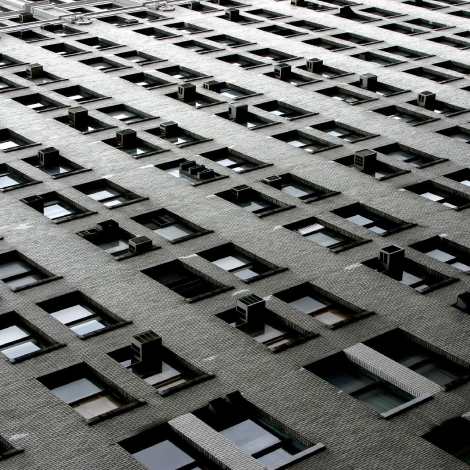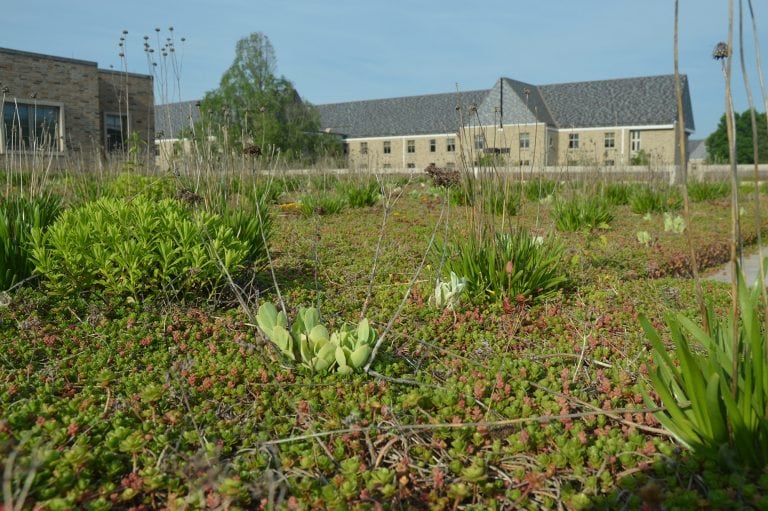One of the numbers that reveals the consequences of poverty in the United States is the energy burden. Low-income households are projected to pay the highest percentage of their income on energy, spending 8.6% to 30% of their income, compared to the middle- and high-income households that spend 3%, according to a report in 2022 by the US Office of Energy and Renewable Energy. Those high energy costs are the legacy of older buildings and inadequate urban planning. As the climate warms and air conditioning becomes a necessity in more homes, costs are expected to climb.
The solutions are regulatory measures, retrofits and research to improve resilience in low-income housing and neighborhoods. We need investments in retrofits, insightful design and urban planning to lower energy costs and reduce the burden on low-income households (and everyone else).
Read more: Green Buildings Can Boost Productivity and Health of Workers
Cooling the indoors in a warming world
Climate change is forcing the need for air conditioning in more and more homes in the United States, and worldwide. By 2050, an additional 4 billion air conditioning units will be demanded by more than 87% of households globally for space cooling. That means an estimated 5.6 billion units, up from 1.6 billion today, according to the International Energy Agency. Running those machines will be a key driver of the growing global energy demand, which is projected to increase three-fold, the IEA reports.
Aging buildings, outdated building codes
As of 2018, 80 percent of single-family housing in the United States was constructed more than 20 years ago. The homes were designed and built in an era of outdated building codes, and their construction was not required to provide resilience against extreme weather events.
Changing climatic conditions have meant higher temperatures during the summer, and cities in particular have endured islands of heat and hotter days than years past. The result has been higher thermal gains in buildings. New measures are required to keep indoor temperatures at safe and comfortable levels.
Focus on low-income households
Low-income households spend a higher percentage of their earnings on energy than the middle- and high-income households in the United States, and that is not expected to change without intervention. As energy needs grow, the highest energy cost burden is still projected to be among low-income households, according to a 2022 report by the US Office of Energy Efficiency and Renewable Energy.
The higher energy burden in low-income housing is directly related to the poor performance of the buildings compared to that of costlier homes. To improve the quality of life in the communities that are most heavily affected, solutions should be measures that build resilience to higher temperatures in low-income housing.
Resilient solutions
Resilience refers to measures that prepare the building for the impact of extreme events, allowing it to withstand the events and undergo rapid, minimal reconstruction after the disaster. With the exponential increase in extreme weather events it is no longer sustainable to wait for the damages to occur in order to implement resilience in our homes. Extensive disaster risk reconstruction is costly, time consuming and disruptive. This justifies the need to push for pre-disaster resilience implementation through investment in resilient building envelopes and energy systems in every household. (The term “building envelope” refers to everything that separates the interior of a building from the outside world).
With the exponential increase in extreme weather events it is no longer sustainable to wait for the damages to occur in order to implement resilience in our homes.
Substandard housing generates a high cooling demand during hot summers, which is the result of high thermal gains through the building envelope, and structural deficiencies. The UN Environment Programme explains the issue in a report published in July, 2021, that is worth a read.
The work to reduce the energy burden must focus on optimizing the building structure and envelope to comply with modern building performance standards. This, according to the US National Energy Codes Conference in 2021, and the US Department of Energy, will lower the energy burden by up to $162 per household annually. Bringing low-income housing into compliance with modern codes and standards will also protect the buildings from heat waves and other extreme events such as hurricanes, strong winds, flooding and earthquakes.
Research could make heat less deadly
There has been less focus on adapting homes to extreme heat, yet it is the deadliest climate-change-related natural disaster. The impact of the high energy burden is a low uptake of mechanical cooling strategies and a high rate of heat-related health and fatalities among low-income households. Research may find solutions. New research should aim to improve the performance of low-income housing during extreme heat events.
Passive and active strategies for heat resilience
Improvement can be achieved through a range of building design or redesign options and materials for new construction, or retrofitting to enhance extreme heat resilience within each community. Such efforts also minimize the cooling loads by mitigating the heat gains from the external environment.
Building or retrofitting existing housing with durable and resilient envelope materials has an added benefit of enhancing the building’s performance during other natural hazards. Heat resilient construction can provide minimal water penetration, resistance to the impact of debris and other benefits.
Strategies at the building scale
The UN Environmental Programme recommends strategies that mitigate the risks of extreme heat and reduce the energy burden in low-income housing.
- Adopt building envelope materials with low heat absorption and high thermal flow resistance to mitigate the transfer of extreme temperatures from the exterior to the interior of the house. A holistic approach to the improvement of the building envelope involves the replacement of poor performance building materials with efficient, durable and resilient materials. The main target for the improvements include the walls, roof, floors and openings.
- Mineral wool insulation installed as part of the building envelope thermal movement. Note that an analysis of the cost benefit of this replacement is necessary to guide a targeted improvement that provides significant heat resilience.
- Better standards and regulations that improve the performance of buildings can increase resilience. Standards must dive deeper and gain relevance to the issues that arise in low-income housing, focusing on energy cost reduction, high indoor comfort and air quality and the resistance of building materials to damage from environmental hazards.
Another evidence-based recommendation is building or retrofitting with insulating concrete forms. ICF, as they are called, can minimize heat gains during extreme heat events while also providing an improved resistance to fire and damage from high-impact hazards such as flying debris picked up in hurricane winds.
Green walls
Surface vegetation and green spaces within the building redirect solar rays and minimize potential heat gains. Introducing features such as green roofs and walls, cool roofs or roof covering through solar panels improves indoor heat performance by reducing heat gains through the envelope.
Solar panels
Solar panels also provide resilience. When demand on the power grid spikes during heat waves, panels can lower the risk of power outages. Solar panels also supplement the energy supply and lower the energy costs for households.
One drawback to solar panels may be their cost, which can be an obstacle especially for lower-income earners. Strategies that can put the price of solar panels within reach include co-ownership, third-party purchasing and subsidies. These kinds of strategies are recommended as mechanisms to lower the sustainable cooling solutions’ costs by distributing the costs of access and use, according to research by the Adrienne Arsht-Rockefeller Foundation Resilience Center.
Orientation
In new construction, building orientation is key. The position of a building determines the solar heat gains through the openings and windows during the hotter summer days. Orienting the building in a way that there are minimal direct solar rays shining through windows can be an effective way to reduce the indoor temperature. This should be accompanied by well thought-out natural ventilation strategies within the house to minimize the cooling loads, thus lowering the energy costs.
Strategies at the urban scale
Wise urban planning can lower the temperature in lower-income neighborhoods. New construction and new built spaces increase the risk of extreme heat. The sun on asphalt parking lots is an example. Creating master plans and development patterns can guide developments to limit the construction of new built spaces. Planning can also make room for vegetation, urban gardens and regulating development into existing green spaces.
Building and community-scale mapping has also been identified as a viable strategy to identify sources of extreme heat. The mapping concept helps with planning and policy for potential mitigation measures, such as identifying areas that may need additional green spaces and vegetation cover as a mechanism to lower the extreme heat levels expected in the future.
Incentives can encourage new construction in vulnerable areas to comply with building codes and also provide buffers to future climate change.
Further research and innovation is also needed to incorporate modern building codes into the housing stock that was constructed before the implementation of the current resilience-focused building regulations and codes.
An investment in people
Meaningful improvement requires holistic vision. Resilience and energy efficiency in low-income housing must be viewed through a wide lens rather than the current siloed approach. These changes can reduce energy costs for the people who earn the least, improving the quality of life for vulnerable populations in the United States. The benefits will be fewer lives lost, more comfortable living spaces and less money spent on repairs after natural disasters. And the consequences of inaction will be lives lost, not just at today’s rate, but at an increased rate as the world heats up in the coming years.
Reading list
- Oh Jeongyoon et al. (2018) Advanced Strategies for Net-Zero Energy Building: Focused on the Early Phase and Usage Phase of a Building’s Life Cycle. MDPI
- United Nations Environmental Programs (2021) A practical guide to climate-resilient buildings and communities.
- Wilson Kallista (2022) Building Envelopes: What they are and how they improve the energy efficiency of a structure. Available from: Therm test instruments
- Arup. Green building envelopes for lower city temperatures
- Ladd Keith and Sarah Meerow (2022) Planning for urban heat resilience. American Planning Association, PAS Report 600
About the Author
Lorine Ouma is a 2022 Engineering for Change Fellow and an architectural engineering graduate student from Penn State University in State College, Pennsylvania (USA) with an undergraduate degree in Quantity Surveying from Kenya.


Great article Lorine! What about Heat Pumps (in combination with rooftop solar) to replace old natural gas equipment. By replacing heating capacity with Heat Pumps cooling is added at the same time!
its probably a dumb idea but do you think adding layers of mylar between 1/2″-3/4″ layers of traditional insulation would help?